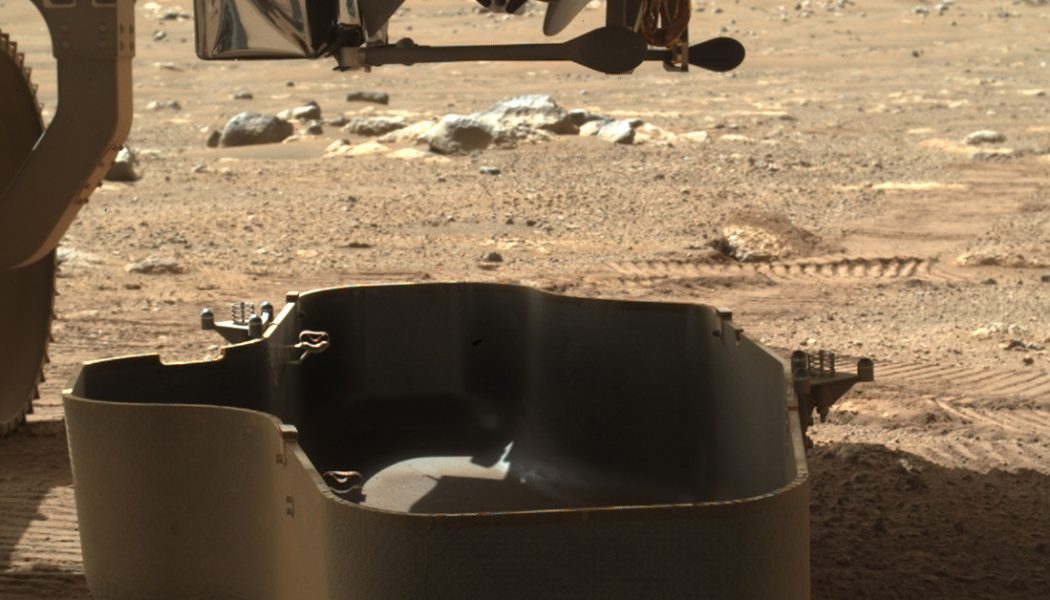
NASA’s Perseverance rover is getting ready to deploy a mini-helicopter named Ingenuity on Mars. The four-pound, four-blade rotorcraft will attempt the first flight of its kind on another planet, and in the process, it will test a new mode of mobility that could transform the way we Earthlings remotely explore other worlds.
The craft is currently attached to the belly of Perseverance, which landed at Mars’ Jezero crater in February. One of the first steps toward setting the baby helicopter off on its debut flight came this weekend when Perseverance dropped a protective shell and exposed Ingenuity to the bright Martian sunlight for the first time. “Away goes the debris shield, and here’s our first look at the helicopter,” the rover’s Twitter account said on Sunday.
Away goes the debris shield, and here’s our first look at the helicopter. It’s stowed sideways, folded up and locked in place, so there’s some reverse origami to do before I can set it down. First though, I’ll be off to the designated “helipad,” a couple days’ drive from here. pic.twitter.com/E9zZGQk5jQ
— NASA’s Perseverance Mars Rover (@NASAPersevere) March 21, 2021
After dropping the debris shield, Perseverance will spend a couple of days driving itself to Ingenuity’s flight zone, which NASA officials plan to unveil in a press conference on Tuesday. The helicopter will be lowered to the ground, and Perseverance will scoot away to a safe distance of about 330 feet, leaving Ingenuity to unlock its rotor blades and carry out a few spin tests. NASA expects the first test flights to come “no earlier than the first week of April,” a statement read.
The artificial boundaries of the flight zone, wherever it is, will be a 50-foot-long oval patch of land that Ingenuity will need to stay within during its flight tests. Perseverance will drop the helicopter off near one end of this flight zone, in a space engineers call the helipad.
Deploying the first helicopter on Mars is no easy task. Ingenuity’s team of engineers at NASA’s Jet Propulsion Laboratory had to account for a Martian atmosphere 100 times thinner than Earth’s, which means the craft needs to work much harder than Earth-bound helicopters to lift itself off the ground.
And it’s not just a more powerful toy drone: Ingenuity is an $85 million spacecraft built to withstand an extremely turbulent ride to Mars — from the violent rumbling during liftoff from Earth last summer to Perseverance’s seven-minute landing sequence through Mars’ atmosphere in February. Its design also has to comply with the international 1967 Outer Space Treaty, which requires signatories to ensure their spacecraft don’t contaminate environments on other planets.
“This was a design challenge that straddled both the aircraft and spacecraft boundaries,” says Bob Balaram, Ingenuity’s chief engineer. The team’s biggest challenge, he said, was creating a craft that can spin its blades fast enough to generate thrust, while keeping the overall design simple and lightweight — “otherwise whatever lift you generate doesn’t do any good if you’ve gotten too heavy in the process in the design.”
Packing all that power in the craft’s four-pound body is made possible by a rectangular solar panel installed above the craft’s four carbon fiber blades. That panel also holds a tiny telecommunications device that can communicate with a node on Perseverance’s body called the Mars Helicopter Base Station, even from as far as nine football fields away. The Base Station will help relay signals back to Earth.
Beneath the blades is a tissue box-sized fuselage that houses flight sensors, two cameras, batteries, and mini “survival heaters” that protect Ingenuity from freezing during nighttime on Mars, where temperatures drop as low as negative 130 degrees Fahrenheit. One of the two cameras has a 13-megapixel color camera facing the horizon that will snap and send images to Perseverance mid-flight (the other camera has a 0.5-megapixel black-and-white sensor used for navigation).
In all, Ingenuity will attempt to carry out five flight tests within a short, 30-day window. If the tests work, similar helicopter tech could be used in other missions, to trek places where wheeled rovers can’t reach, like caves, tunnels, or mountaintops. Ingenuity won’t fly again after its 30-day window, even if the tests are wildly successful. That’s because “we are being accommodated by a major flagship mission that’s got a huge, new astrobiology exploration ahead of it,” Balaram says. Perseverance’s primary mission is to explore Mars’ Jezero crater and pack soil samples into tiny, cigar-sized sample tubes that the rover will scatter around the surface for a future “fetch” rover to send back to Earth.
After that 30-day window, Ingenuity will lie on the Martian surface for eternity. If the craft’s first flight attempt doesn’t work out, Balaram said his team can still celebrate a number of achievements they’ve already made.
“I think the main thing is, we’ve already achieved a lot of milestones just by having a design that could do all of these things, and we have had a successful test program so far,” he said. “Every step is something to celebrate because nothing is a given. It’s a fairly high-risk, high-reward type of activity. And tech demos are inherently a quite risky venture, they’re not a slam dunk.”










